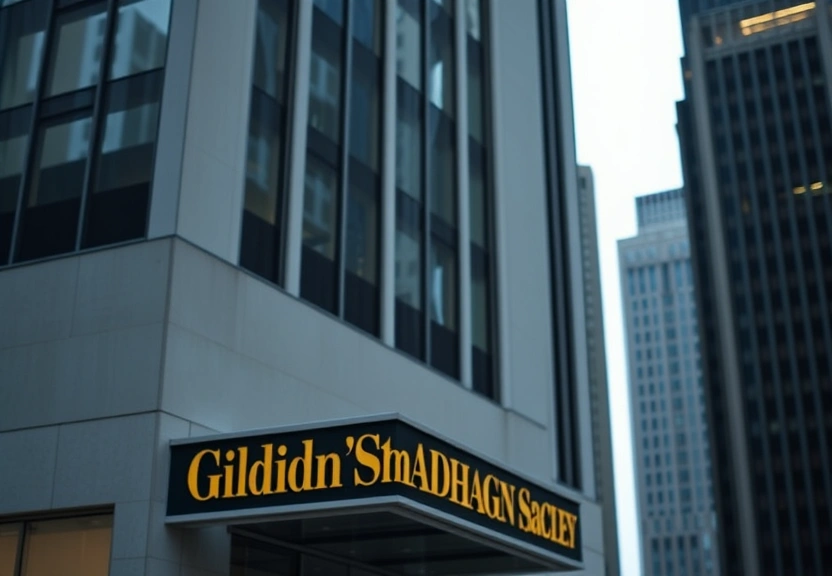Goldman Sachs and Morgan Stanley Post Strong Earnings Amid Trading Surge, But Shares Dip
In a surprising turn of events, shares of Goldman Sachs and Morgan Stanley experienced a decline on Wednesday, despite reporting stronger-than-expected earnings. This development has raised eyebrows in the financial community, especially as both banks benefitted from a notable surge in trading activity during the quarter. Investors, it seems, are taking a cautious approach, refraining from pushing equity prices higher after recent gains in the stock market.

The earnings reports from these significant players in the banking sector have underscored the resilience of their trading operations, which have been a boon amid fluctuating market conditions. However, the observed dip in their stock prices has highlighted a complex relationship between strong earnings and market sentiment, raising questions about future performance and investor behavior.
Understanding the Earnings Reports
Goldman Sachs and Morgan Stanley both released their earnings reports for the previous quarter, showcasing impressive results driven primarily by robust trading revenues. Let’s delve into the specifics of each bank’s performance and key factors influencing their financial outcomes.
Goldman Sachs: Key Highlights
Goldman Sachs reported a significant increase in its earnings, driven by a surge in trading volumes and strong performance in investment banking. The key highlights of their earnings report include:
- Net Earnings: Goldman Sachs reported a net income of $2.5 billion, surpassing analysts’ expectations.
- Trading Revenue: A 30% increase in trading revenue compared to the previous quarter, attributed to heightened market volatility.
- Investment Banking: Fees from investment banking also showed resilience, reflecting strong demand for advisory services.
Morgan Stanley: Key Highlights
Similarly, Morgan Stanley’s earnings report reflected robust trading performance, bolstered by a strong showing in wealth management. The notable points from their report include:
- Net Income: Morgan Stanley reported a net income of $2.2 billion, exceeding market forecasts.
- Trading Desk Performance: Trading desks generated a 25% increase in revenues, driven by equity and fixed-income trading.
- Wealth Management: The wealth management division contributed to steady earnings, with a focus on client assets and advisory services.
Factors Contributing to the Trading Surge
The surge in trading activity at both Goldman Sachs and Morgan Stanley can be attributed to several factors that have shaped the market landscape in recent months. Understanding these factors provides insight into the broader economic environment influencing banking operations.
Market Volatility
One of the primary drivers of increased trading activity has been the heightened market volatility experienced in recent months. Economic uncertainties, geopolitical tensions, and fluctuating interest rates have prompted traders and investors to react swiftly to changing market conditions, leading to elevated trading volumes.
Interest Rate Environment
The Federal Reserve’s monetary policy, particularly regarding interest rates, has also played a crucial role. As rates remain low, investors have sought opportunities in various asset classes, resulting in a surge in trading. This environment has favored banks like Goldman Sachs and Morgan Stanley, allowing them to capitalize on increased trading volumes.
Technological Advancements
Furthermore, technological advancements in trading platforms and analytics have enabled banks to execute trades more efficiently and respond to market changes swiftly. This enhancement has empowered traders at Goldman Sachs and Morgan Stanley to capture opportunities more effectively, contributing to the surge in trading revenue.
Investor Sentiment and Stock Performance
Despite the strong earnings reports, the stock prices of both Goldman Sachs and Morgan Stanley dipped on the day following the announcements. This counterintuitive reaction raises important questions about investor sentiment and market dynamics.
Profit-Taking Behavior
One possible explanation for the decline in share prices is the profit-taking behavior of investors. After a series of gains in the stock market, investors may have opted to realize profits, leading to a temporary pullback in stock prices. This is a common occurrence in financial markets, especially after substantial rallies.
Cautious Outlook
Additionally, investors may have adopted a cautious outlook amid ongoing economic uncertainties. While the earnings reports were strong, concerns about inflation, potential interest rate hikes, and geopolitical tensions could have led investors to reassess their positions, resulting in a dip in share prices.
Market Reactions and Future Outlook
The reactions of the stock market following the earnings reports from Goldman Sachs and Morgan Stanley have sparked discussions regarding the future trajectory of these financial giants. Analysts and investors alike are contemplating how the current market dynamics will affect both banks moving forward.
Analyst Predictions
Market analysts are divided on the future outlook for Goldman Sachs and Morgan Stanley. Some believe that the strong performance in trading could continue, especially if market conditions remain volatile. Others, however, caution that external factors could play a significant role in shaping future earnings.
Long-Term Growth Strategies
Both banks have emphasized their commitment to long-term growth strategies, focusing on diversifying their revenue streams. This includes investing in technology, enhancing client services, and expanding into new markets. As they navigate the complexities of the financial landscape, their ability to adapt will be crucial to maintaining investor confidence.
Conclusion
The recent earnings reports from Goldman Sachs and Morgan Stanley demonstrate the resilience of these banking giants amid a trading surge. Strong profits driven by trading revenues highlight their ability to navigate complex market conditions. However, despite the positive financial results, investor sentiment and market behavior led to a dip in their share prices, emphasizing the intricate relationship between earnings and stock performance.
As both banks continue to adapt to changing market dynamics and economic uncertainties, maintaining a focus on long-term growth and strategic investments will be essential. Investors will need to keep a close watch on market trends and the banks’ responses to ensure informed decision-making moving forward.
Frequently Asked Questions (FAQs)
1. Why did Goldman Sachs and Morgan Stanley’s shares dip despite strong earnings?
The shares dipped primarily due to profit-taking behavior among investors and a cautious outlook amid ongoing economic uncertainties.
2. What factors contributed to the trading surge at these banks?
Heightened market volatility, a favorable interest rate environment, and technological advancements in trading platforms contributed to the surge in trading activity.
3. How do market conditions affect the performance of banks like Goldman Sachs and Morgan Stanley?
Market conditions, including interest rates, economic stability, and geopolitical factors, significantly impact trading volumes and investment banking activities, influencing overall bank performance.
4. What are the long-term growth strategies of Goldman Sachs and Morgan Stanley?
Both banks focus on diversifying revenue streams, investing in technology, enhancing client services, and exploring new markets to ensure sustainable growth.
5. Should investors be concerned about the recent dip in share prices?
While short-term stock fluctuations can be concerning, investors should consider the overall financial performance and long-term strategies of the banks before making decisions.
📰 Original Source
Este artigo foi baseado em informações de: https://www.marketwatch.com/story/goldman-sachs-stock-jumps-after-a-big-earnings-beat-amid-strength-in-investment-banking-and-equities-businesses-bed07056?mod=mw_rss_topstories


